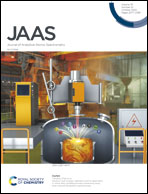Study of interpulse delay effects on orthogonal dual-pulse laser-induced breakdown spectroscopy in bulk seawater
Abstract
With the application of an orthogonal dual-pulse laser-induced breakdown spectroscopy (DP-LIBS) excitation, when compared to single-pulse LIBS (SP-LIBS), significant emission intensity enhancements for a wide range of elements are obtained in seawater. The influence of time delay between two laser pulses on the underwater laser-induced plasma characteristics was investigated by means of fast imaging and spectroscopic techniques. In this study, we demonstrated that the LIBS signal intensity cannot be improved by using two simultaneously incident laser beams, even though the two induced plasmas fused together well. When using suitable shorter interpulse delay (40 μs), before the bubble is fully expanded (140 μs), more uniform volumetric emission with higher spectral intensity and longer plasma lifetime can be generated at a relatively low energy of the second laser (30 mJ). Finally, we also suggest that H and O produced from water by the LIBS plasma can be regarded as the internal standard for underwater DP-LIBS practical applications.



 Please wait while we load your content...
Please wait while we load your content...